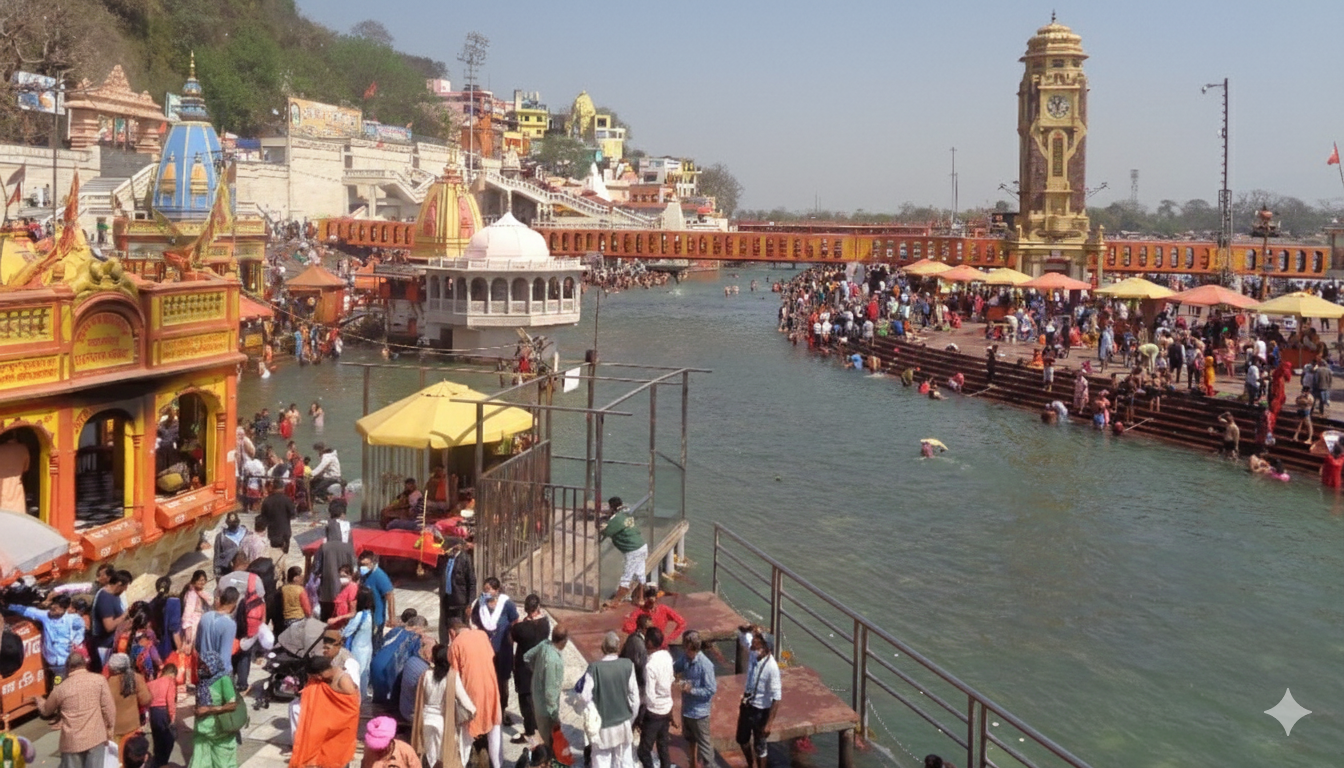Reliving the Glory of Ancient Kingdoms
To relieve the stress of modern chaotic city life and instead relive the timeline of some good old ancient kingdoms that we came across in our history books, one should roam around the state of Tamil Nādu. To realize the contribution of those kings and their rule in the overall life and culture of the state that remain intact even after centuries, visit the temples, forts, museums, and other monuments scattered across the land.
Tamil Nādu, a state that holds a prominent space in the divine world, is blessed to have had some royal kings and kingdoms who built amazing temples and structures. Chidambaram, Madurai Meenakshi Kovil, Rameswaram Temple, and Mahabalipuram are only a few among many.
Thanjavur – A Living Chapter of History
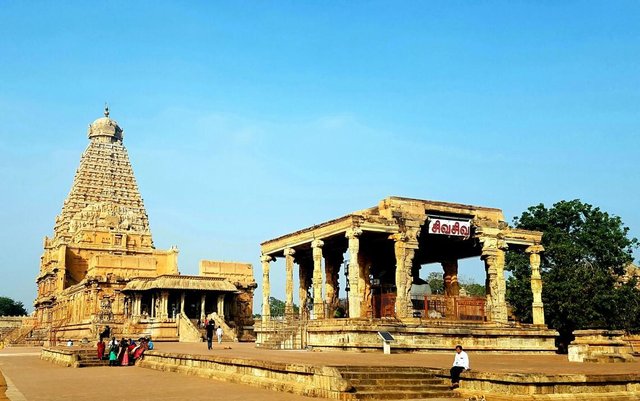
Thanjavur is one among many such places in Tamil Nādu known for its centuries-old royalty. Travellers will be surprised by the temples, arts, paintings, architecture, and music that were the hallmarks of the 10th to 14th centuries but still play an important role in the city’s life and tourism. Historically, this place is also believed to be the birthplace of classical Carnatic music and Bharatanatyam, the classical form of dance.
Situated on the eastern coast of the state, Thanjavur is about 350 kilometres from the capital city Chennai and around 50 km east of Tiruchirappalli. It was once the capital of the great Chola Empire from the 9th to the 11th century. The Big Temple, or Brihadeeswara Temple, is the main attraction here and is also one of UNESCO’s World Heritage Sites. The river Kaveri is connected to this place, and apart from the Big Temple, there are other attractions like the Saraswati Mahal, Art Gallery, and more.
The Majestic Brihadeeswara Temple @ Thanjavur
Brihadeeswara, or the Big Temple, built by the Chola dynasty in the 10th century and located on the southern bank of the Cauvery River, is the very identity of Thanjavur Apart from its divine presence, the architectural brilliance of this structure is another major reason people visit this place.

A casual look from the parking lot across the road makes it seem like any typical Tamil Nadu temple, but once inside the massive premises, the towering vimana, the gigantic statue of Nandi (the bull), the entrance gate, and the detailed gopuram reveal why this temple is extraordinary and why Tanjore remains as important as it was many centuries ago.
First Impressions – More Like a Fort Than a Temple
The entrance gate with its big arch and sculptures may not immediately arouse curiosity, but the extended wall along the boundary resembles a fort rather than a temple. Between the outer and inner gates, brief historical details and a plan of the temple complex are displayed at a convenient height for visitors.

Inside the Complex – A Marvel Beyond Words
Inside the temple complex, it’s a “see it to believe it” experience. The sheer size of the complex, as big as several football fields, with the main temple standing tall at around 60 meters, is breathtaking. The long extension leading to the devotees’ entrance, built in the same stone style, makes the whole structure look majestic.
Another smaller structure houses the huge Nandi in front of the temple. The long boundary walls on all sides, with a covered corridor attached inside, each tell their own story. The temple truly lives up to its name – the Big Temple.
The Giant Nandi and the Divine Core
As I stepped inside, my first instinct was to capture photographs in the soft morning sunlight, but the sight of the mighty Nandi reminded me of the real purpose — to complete the customary temple visit. The Nandi, believed to be carved from a single stone, is massive, measuring about 4 meters high, 6 meters long, and 2.5 meters wide, making it the second-largest in India. It stands on an elevated platform directly facing the temple.
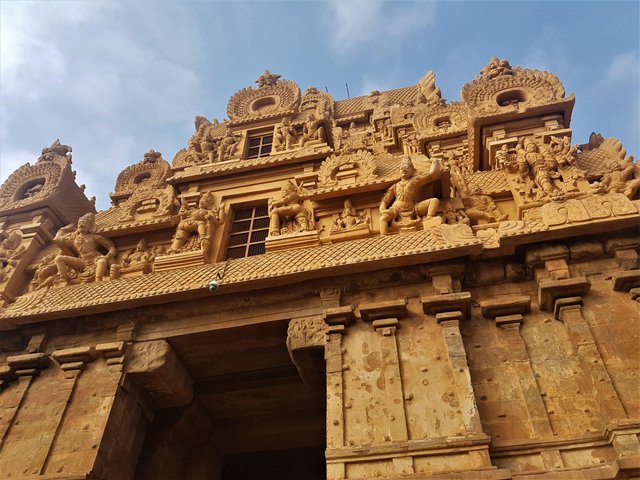
A Divine Yet Architectural Experience of Thanjavur
There were a fair number of visitors from different states, especially from the southern parts of India, as this temple is a popular stop on devotional tours. The long line for darshan stretched outside the main door near the Nandi idol.
Once inside, I noticed that the main idol was at quite a distance. While many stood silently chanting slokas, my traveller’s heart was in conflict with my spiritual side — the beauty of the architectural and engineering precision around me kept drawing my eyes.
The pillars in the long hall, the stone carvings, the murals on the ceiling, and the perfect alignment of structures all stood as a testament to the extraordinary craftsmanship of a thousand years ago — created without any modern machines or cranes.
The Sanctum and the Towering Vimana of Thanjavur
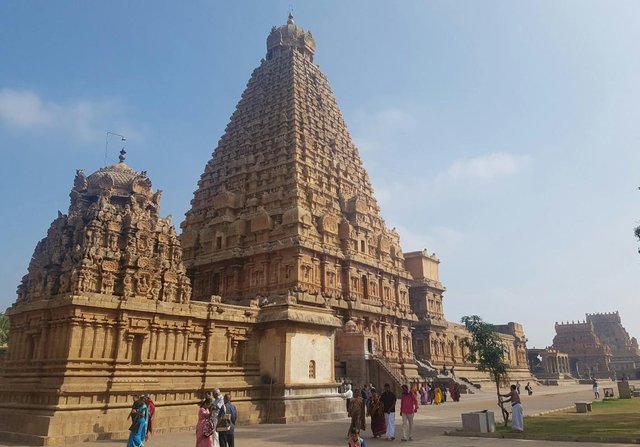
The sanctum sanctorum, where the main idol resides, is not open to all. The Shiva Linga inside is massive, about 3–4 meters in height, fitting perfectly with the scale of the temple. A side door allows devotees to exit after darshan.
The entire structure, with its 15–16-storey-high tower and the dome-like Kumbham on top, showcases architectural genius. Legends say the massive dome was lifted to its height using an earthen ramp almost six kilometres long, starting from a nearby village.
Walls that Speak of Art and Culture
The surrounding walls are adorned with beautiful depictions of Bharatanatyam dance poses, showing how deeply art and culture were embedded in the Chola era. The intricate stone carvings and the perfect symmetry of the tower and outer walls prove how skilled the artisans, masons, and sculptors of that time were — setting a professional standard that even modern architects and engineers would admire.
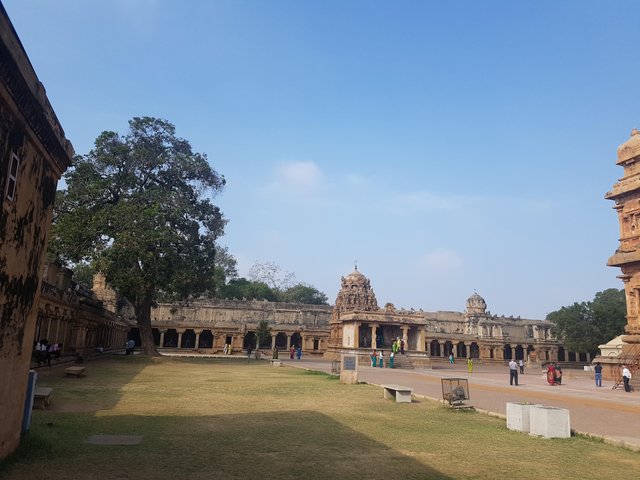
Beyond the Temple – Exploring Tanjore Palace and Museums
Having some time left, I decided to explore other historical spots before leaving Tanjore. A few locals and an online search directed me to the Tanjore Palace, Saraswati Mahal Library, Museum, and Bell Tower — all within the same compound.
These structures, built in the 15th or 16th centuries, are not as old as the Big Temple but equally important. However, what I found here were two contrasting faces of tourism within just a kilometre’s distance. This area, once royal, now appeared unorganized, unattended, and unwelcoming for travellers. It’s unclear if any renovation was ongoing, but the place clearly lacked the maintenance it deserved.
The Fading Royalty of the Palace
With a small entrance fee, visitors can access all key sections displaying artefacts from the royal era — coins, war equipment, kitchen utensils, royal attires, and uniforms — all arranged in two museum sections. A wall with windows separates them, opening into a courtyard that seems to have fallen into neglect.
The Durbar Hall, with its faded paintings, gives glimpses of a once-glorious past now fading into time.
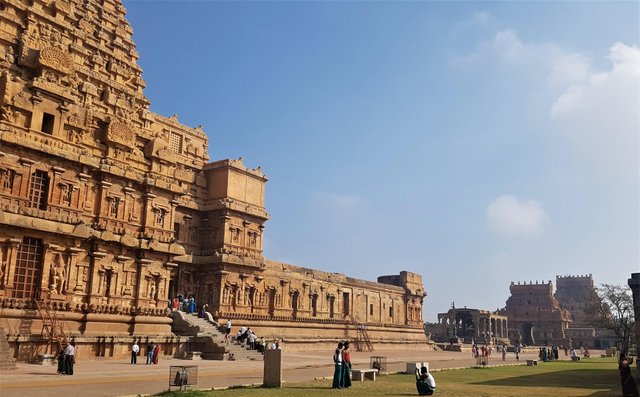
The Pride of Saraswati Mahal and Art Gallery
The Saraswati Mahal Library, however, stood apart — well-maintained and filled with a vast collection of books, manuscripts, and paintings. It reflects the rulers’ keen interest in knowledge and preservation for future generations.
Nearby, the Art Gallery is neatly organized, displaying beautiful bronze statues of Lord Shiva in various Nataraja poses, along with stone carvings and statues of ancient rulers. Visitors can also climb up to see the Bell Tower from here.
Final Reflections
From this quick visit, it is clear that Tanjore has enough space, history, and heritage to keep travellers engaged for days. While some areas need better attention and organization, the state deserves appreciation for maintaining most of these ancient structures so well even after centuries.
A visit to Tanjore is not just a walk through temples and palaces — it’s a walk through time itself, carrying with it a sense of pride, awe, and deep cultural connection that stays long after you’ve left the city.
Click here for Wikipedia page



